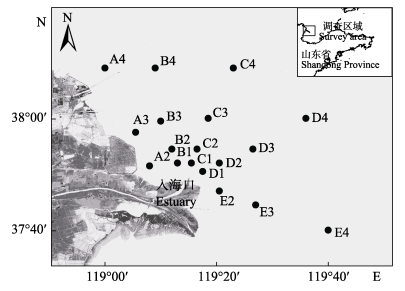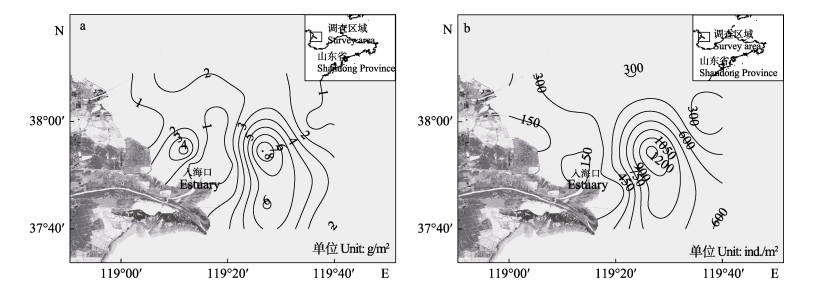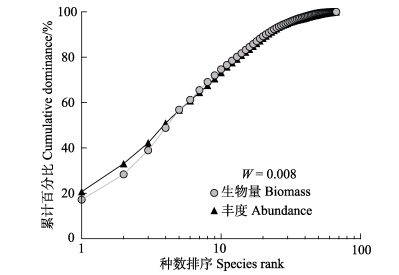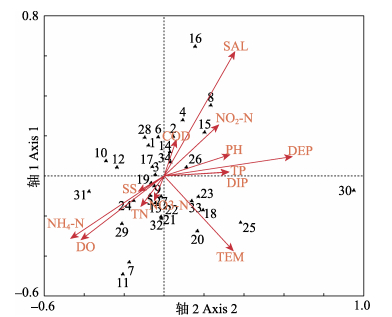2. 中国科学院海洋研究所 海洋生态与环境科学重点实验室 青岛 266071;
3. 烟台市水产研究所 烟台 264003
2. Key Laboratory of Marine Ecology and Environmental Sciences, Institute of Oceanology, Chinese Academy of Sciences, Qingdao 266071;
3. Yantai Fisheries Research Institute, Yantai 264003
黄河口海域是陆地海洋交汇的过渡带,受到人类活动和自然界的双重影响,生态系统较脆弱。大型底栖动物是黄河口海域生态系统的重要组成部分,它们参与生物地球化学循环,维持生态系统的结构功能,是监测生态系统变化的重要研究对象(Graf et al, 1997; Heip et al, 2001; 田胜燕等, 2009)。
国内对于黄河口大型底栖动物的研究基本集中于潮间带、滩涂湿地等区域,涉及到群落结构、多样性(夏江宝等, 2009; 李佳芮, 20111); 董贯仓等, 2012; 冷宇等, 2013a、b)、次级生产力(姚晓, 20102); 王志忠等, 2012)等诸多方面,但关于黄河口近海海域大型底栖动物的生态学研究鲜见。本研究以2012年夏季黄河口海域的大型底栖动物和环境调查资料为基础,阐述了大型底栖动物的生态学特征,分析了其与黄河口海域环境因子的关系,以期为黄河口海域生态系统的深入研究和保护提供参考依据。
1) Li JR. Macrobenthic ecology of the intertidal zones of Yellow River delta. Doctoral Dissertation of Ocean University of China, 2011 [李佳芮. 黄河三角洲潮间带大型底栖生物生态学研究. 中国海洋大学博士研究生学位论文, 2011]
2) Yao X. Study on the benthic productivities in the southern intertidal area of the Yellow River Delta. Doctoral Dissertation of Ocean University of China, 2010 [姚晓. 黄河三角洲南部潮间带底栖生产力研究. 中国海洋大学博士研究生学位论文, 2010]
1 研究海域与方法 1.1 调查海域及站位布设2012年6月调水调沙前对黄河口海域的18个站位进行了调查,调查范围为37°40'–38°09'N,119°00'– 119°40'E(图 1)。距黄河入c面,Ⅰ断面(B1、C1、D1站)距离入海口5 km,Ⅱ断面(A2、B2、C2、D2、E2站)距离入海口10 km,Ⅲ断面(A3、B3、C3、D3、E3站)距离入海口20 km,Ⅳ断面(A4、B4、C4、D4、E4站)距离入海口40 km。

|
图 1 黄河口调查站位 Figure 1 Sampling stations at theYellow River Estuary |
使用0.05 m2的抓斗采泥器,每个站位采样4次,使用0.5 mm的套筛现场冲洗后用5%的甲醛溶液固定,在实验室进行分类鉴定。
同步测定站位水深(DEP)及底层水体的温度(TEM)、盐度(SAL)、pH值、悬浮物(SS)、溶解氧(DO)、化学需氧量(COD)、总氮(TN)、总磷(TP)、活性磷酸盐(DIP),包括硝酸盐(NO3-N)、亚硝酸盐(NO2-N)和氨氮(NH4-N)。采样和室内分析方法按《海洋调查规范》(GB/T 12763.9-2007)进行。
1.3 数据处理 1.3.1 生态优势度计算Pinkas相对重要性指数(IRI)以确定物种在群落中的重要性(Pinkas et al, 1971)。
| $ {\rm{IRI = }}\left({{W_i} + {N_i}} \right) \times {F_i} \times {10^4} $ |
式中,Wi为第i种底栖动物的重量在总样品重量中所占的百分比,Ni为第i种底栖动物的个体数在总样品个体数中所占的百分比,Fi为第i种底栖动物在取样站位的出现率。将IRI > 1000的物种定义为优势种。
1.3.2 多样性指数根据黄河口海域大型底栖动物群落的特点及取样数据,采用以下公式进行多样性分析(Margalef, 1957; Wilhm, 1968):
Margalef种类丰富度指数
| $d = \frac{{S - 1}}{{{\rm{lo}}{{\rm{g}}_2}N}}$ | (1) |
Shannon-Wiener多样性指数
| $H' = - \mathop \sum \limits_{i = 1}^S {P_i}{\rm{lo}}{{\rm{g}}_2}{P_i}$ | (2) |
Pielou均匀度指数
| $J = \frac{{H'}}{{{\rm{lo}}{{\rm{g}}_2}S}}$ | (3) |
式中,d为种类丰富度指数,H'为Shannon-Wiener多样性指数,J为Pielou均匀度指数,S为采泥样品中的种类总数,N为采泥样品中所有种类的总个体数,Pi为第i种的个体数与样品中的总个数的比值。
1.3.3 群落结构采用非参数多变量分析群落结构,对各站位大型底栖动物的栖息密度进行4次方根转换,选择至少在2个或2个以上位点出现,至少1个站位的相对丰度≥1%的属种用于分析(王宗兴等, 2012),根据群落Bray-Curtis相似性系数,采用等级聚类的方法和非度量多维标度(NMDS)的排序方法分析调查站位的大型底栖动物结构特征(Clarke et al, 2001; Field et al, 1982)。
1.3.4 ABC曲线采用丰度/生物量比较曲线(ABC曲线)来分析群落的受干扰情况,用W统计量作为ABC曲线法的一个统计量,其公式为:
| $W = \mathop \sum \limits_{i = 1}^S \frac{{\left({{B_i} - {A_i}} \right)}}{{50\left({S - 1} \right)}}$ |
式中,Bi和Ai为ABC曲线中种类序号对应的生物量和数量的累积百分比,S为出现的种类数(Warwick, 1986; Clarke et al, 2001)。
1.3.5 与环境因子相关分析使用Canoco for Windows 4.5对大型底栖动物的丰度与环境因子间的关系进行典范对应分析(Canonical correspondence analysis, CCA)(TerBraak, 1987)。排除IRI≤10的物种以减少干扰(廖一波等, 2011),物种和环境数据进行lg(x+1)转换,避免不同指标单位造成的统计偏差(Flores et al, 1998)。
2 结果与分析 2.1 种类、数量组成和优势种经过分析鉴定,调查海域共采到大型底栖动物67种,隶属于6门53科。其中,多毛类种数最多,为28种,占41.79%;节肢动物为17种,占25.37%;软体动物为16种,占23.88%;棘皮动物和其他类群各3种,占4.48%。各类群生物量和栖息密度占比情况见表 1。
|
|
表 1 黄河口海域大型底栖动物各类群占比 Table 1 Proportion of each group of macrobenthos at the Yellow River Estuary (%) |
该海域生物量和栖息密度的平均值分别为2.03 g/m2和358 ind./m2;以C1–C4站为中线,调查海域的东侧生物量和栖息密度总体要高于西侧;从Ⅰ–Ⅳ断面生物量和栖息密度表现出先增后减的变化趋势,在D3站位附近生物量和栖息密度均出现峰值(图 2)。

|
图 2 黄河口海域大型底栖动物的生物量(a)和栖息密度(b)分布 Figure 2 Biomass (a) and abundance (b) distribution of macrobenthos at the Yellow River Estuary |
调查海域大型底栖动物优势种有3种,为无尾涟虫(Leucon sp.)、丝异须虫(Heteromastus filiforms)和寡节甘吻沙蚕(Glycinde gurjanovae),优势种占本次调查大型底栖动物质量的7.49%,数量的42.22%;重要种有16种,分别是江户明樱蛤(Moerella jedoensis)、纵沟纽虫(Lineus sp.)、昆士兰稚齿虫(Prionospio queenslandica)等,常见种和少见种分别为16种和32种。
2.2 多样性指数调查海域的种类丰富度指数d平均值为2.643,最高值出现在D3站,最低值出现在B1站;物种多样性指数H'平均值为3.078,以E3站最高,B1站最低;物种均匀度指数J平均值为0.793,A3站最高,D3站最低(表 2)。
|
|
表 2 黄河口海域大型底栖动物多样性指数 Table 2 Diversity indices of macrobenthos at the Yellow River Estuary |
对各站位大型底栖动物群落结构进行聚类分析见图 3。从图 3可以看出,在30%的相似水平上可将18个站位分为3组,其中,C4、D4站为Ⅰ组,群落组成为长尾虫(Apseudes sp.)、日本鳞缘蛇尾(Ophiophragmus japonicus)、钩虾1种(Gammaridea sp.);C1、B1站为Ⅲ组,为丝异须虫、背蚓虫(Notomastus latericeus)群落;其余站位为Ⅱ组,为寡节甘吻沙蚕、江户明樱蛤、无尾涟虫群落。多维排序尺度方法(MDS)分析图中胁强系数Stress=0.17 < 0.2,表示分析结果有一定的解释意义。

|
图 3 黄河口海域大型底栖动物聚类树枝图(a)和MDS(b)排序分析 Figure 3 Cluster(a) and MDS(b) analysis of macrobenthos at the Yellow River Estuary |
根据调查海域大型底栖动物的丰度和生物量绘制ABC曲线见图 4。从图 4可以看出,丰度和生物量曲线重叠相交,表明黄河口海域的大型底栖动物群落倾向于受到中等程度的扰动。

|
图 4 黄河口海域大型底栖动物ABC曲线 Figure 4 ABC curve of macrobenthos at the Yellow River Estuary |
对黄河口海域的大型底栖动物种类数据进行筛选后得到34种,对其进行编号(表 3)。经DCA分析,前2个排序轴的特征值分别为0.264和0.151,4个轴分布的最大梯度长度为3.324,说明可以采用单峰模型的典范对应分析(CCA)进行排序。
|
|
表 3 黄河口海域主要大型底栖动物种名录 Table 3 List of main macrobenthos species at the Yellow River Estuary |
CCA排序结果前2轴与物种和环境因子的相关系数分别达到0.960和0.984,所有排序轴对物种和环境因子关系的累积贡献率达到57.2%(图 5)。水深与第1排序轴相关性最高(r=0.590),其次为氨氮(r=–0.427);盐度与第2排序轴相关性最高(r=0.588),其次为水温(r=–0.349)。

|
图 5 黄河口海域大型底栖动物与环境因子关系的CCA排序 Figure 5 CCA ordination of the relationships between macrobenthos and environmental factors at the Yellow River Estuary SAL:盐度;DEP:水深;COD:化学需氧量;DO:溶解氧;NH4-N:氨氮;NO2-N:亚硝酸盐;NO3-N:硝酸盐;DIP:无机磷;TP:总磷;TN:总氮;SS:悬浮物;TEM:水温;pH:酸碱度 |
由图 5可以看出,Ⅰ组出现的优势种类有长尾虫、钩虾1种和日本鳞缘蛇尾,它们集中分布在第1排序轴右侧,说明这些种类与水深、水温、盐度呈正相关;Ⅱ组出现的优势种类有无尾涟虫、江户明樱蛤、寡节甘吻沙蚕,分布在第1排序轴的左侧靠近中心区域,这些种类与各环境因子的相关性不明显;Ⅲ组的优势种类丝异须虫、背蚓虫分布在第1排序轴左侧,与氨氮、硝酸盐、总氮和溶解氧呈正相关性。
3 讨论 3.1 群落时空分布结合历史调查资料,在相同的采样条件下,2004–2009年黄河口海域调查大型底栖动物生物量平均值为8.74 g/m2,栖息密度平均值为260 ind./m2 (冷宇等, 2013a),本次调查栖息密度高于历史调查值,而生物量却低于历史调查值,可以推测黄河口海域大型底栖动物种群总体可能向小个体种类演变。
从空间尺度上看,根据调查结果可以发现,调查海域大型底栖动物的生物量、栖息密度以及生物多样性指数的高值区域都出现在Ⅲ断面的东侧海域,而低值区域则出现在黄河入海口周围。形成这种分布格局的原因可能是入海口处直接受河水和泥沙扰动,生态环境较复杂,而远离河口处的海域环境较为稳定,所以大型底栖动物群落结构也相对稳定。刘录三等(2008)在研究辽东湾北部海域大型底栖动物时发现,辽河、双台子河等河流携带大量陆源污染物入海,这些污染物会对河口的底栖生物产生抑制作用;王瑜等(2010)研究渤海湾近岸海域底栖动物群落时发现,位于海河口附近站位的底栖动物群落组成受到了限制,而位于流速低、颗粒沉降快、含沙量高的远河口站位由于生境适宜,大型底栖动物种类数量丰富,上述研究报道与本研究结果是一致的。
3.2 多样性Shannon-Wiener多样性指数常用来监测淡水、海水底栖动物群落结构的变化,是一个较好的评价工具(李永祺等, 1991)。Chainho等(2007)提出的多样性指数合理范围,黄河口海域大型底栖动物的物种多样性指数为“好(3.0–4.0)”。多样性的低值区域为河口的B1和C1站位,级别为“差(1.0–2.0)”,2个站位出现的种类数分别为5种和7种,其原因可能是河口存在盐度梯度和其他物理化学因子的变化,仅有少数生物能够适应和忍受生存条件的快速变化,最终导致河口海域相对较低的生物多样性(Miller et al, 1985; 沈国英等, 2010)。多样性指数的高值区域分布在远离河口的海域,多数站位级别为“好”,推测原因有两点,其一,离河口较远的海域受扰动相对较小;其二,黄河会携带大量营养物质入海,这些营养物质可能扩散一定的距离后才会沉淀,这种营养物质的输移对于维系黄河口海域的生物多样性水平和生态系统稳定性有非常重要的作用(张敬怀, 2014)。
3.3 优势种及其与环境因子的关系根据以往的调查资料,20世纪80–90年代黄河口底栖动物占据优势的种类是棘皮动物和软体动物(张志南等, 1990),本次调查发现,大型底栖动物多毛类占比重最大,优势种为小型个体的寡节甘吻沙蚕和丝异须虫,棘皮动物所占比重最小,且重要种也鲜见大个体底栖动物。据何明海等(1988)对厦门西港底栖生物的研究报道,棘皮动物数量减少甚至绝迹,多毛类机会种大量繁殖,这是底栖动物群落对于环境污染或人为扰动做出的反应,这种变化与莱州湾大型底栖动物的种类组成变化是相同的(李少文等, 2013)。
本次调查发现,各采样站位无机氮均达Ⅳ类海水水质标准(GB3097-1997《海水水质标准》),B2、B3和D2站位劣于Ⅳ类海水水质标准,可见黄河口海域无机氮水平较高。Pearson等(1978)早在20世纪70年代就提出,多毛类机会种(如丝异须虫、小头虫等)在环境受到污染或人为扰动后可以迅速增殖,可作为环境扰动的指示生物。本研究的排序分析结果显示,优势种丝异须虫与氨氮、硝酸盐呈正相关性;此外,ABC曲线显示,丰度和生物量曲线重叠相交,说明黄河口海域的大型底栖动物群落倾向于受到中等程度的干扰。
黄河调水调沙也是长期影响黄河口海域大型底栖动物群落的重要因素。调水调沙的时间一般在每年6月中下旬,历时20 d,这个时间是各种海洋生物的生长繁殖季节,尤其是浮游生物的大量繁殖,可以为大型底栖动物提供充足的食物来源。而黄河口海域每年受调水调沙带来的大量水沙和上游物质影响,其水环境和沉积物环境可能发生一定程度的改变,这种改变具有延滞效应,需要长期监测才能发现其作用规律(李少文等, 2015)。
| Chainho P, Costa JL, Chaves ML, et al. Influence of seasonal variability in benthic invertebrate community structure on the use of biotic indices to assess the ecological status of a Portuguese estuary. Marine Pollution Bulletin, 2007, 54(10): 1586-1597 DOI:10.1016/j.marpolbul.2007.06.009 | |
| Clarke KR, Warwick RM.. Change in marine communities: An approach to statistical analysis and interpretation (2nd edition). Plymouth, UK: PRIMER-E Ltd, 2001. | |
| Dong GC, Li XQ, Liu F, et al. Community characteristics of macrozoobenthos and environmental quality assessment in intertidal zone of the Huanghe Delta. Marine Environmental Science, 2012, 31(3): 370-374 [董贯仓, 李秀启, 刘峰, 等. 黄河三角洲潮间带底栖动物群落结构分析及环境质量评价. 海洋环境科学, 2012, 31(3): 370-374] | |
| Field JG, Clarke KR, Warwick RM. A practical strategy for analysing multispecies distribution patterns. Marine Ecology Progress Series, 1982, 8(1): 37-52 | |
| Flores LN, Barone R. Phytoplankton dynamics in two reservoirs with different trophic state (Lake Rosamarina and Lake Arancio, Sicily, Italy). In: Alvarez-Cobelas M, Reynolds CS, Sánchez-Castillo P, et al (eds). Phytoplankton and trophic gradients. Developments in Hydrobiology, vol 129. Dordrecht: Springer, 1998 | |
| General Administration of Quality Supervision, Inspection and Quarantine of the People's Republic of China, Standardization Administration of the People's Republic of China. Specification of oceanographic survey—Part 9: Guidelines for marine ecological survey (GB/T12763.9-2007), 2007 [中华人民共和国国家质量监督检验检疫总局, 中国国家标准化管理委员会. 海洋调查规范第9部分: 海洋生态调查指南(GB/T12763. 9-2007), 2007] | |
| Graf G, Rosenberg R. Bioresuspension and biodeposition: A review. Journal of Marine Systems, 1997, 11(3-4): 269-278 DOI:10.1016/S0924-7963(96)00126-1 | |
| He MH, Cai EX, Wu QQ, et al. Ecology of benthos in west harbour of Xiamen. Journal of Oceanography in Taiwan Strait, 1988, 7(2): 189-194 [何明海, 蔡尔西, 吴启泉, 等. 厦门西港底栖生物的生态. 台湾海峡, 1988, 7(2): 189-194] | |
| Heip CHR, Duineveld G, Flach E, et al. The role of the benthic biota in sedimentary metabolism and sediment-water exchange processes in the Goban Spur area (NE Atlantic). DeepSea Research PartⅡ: Topical Studies in Oceanography, 2001, 48(14-15): 3223-3243 DOI:10.1016/S0967-0645(01)00038-8 | |
| Leng Y, Liu YT, DU M, et al. Temporal and spatial variation of macrofaunal communities in the Estuary of Yellow River during spring of 2004-2009. Acta Oceanologica Sinica, 2013a, 35(6): 128-139 [冷宇, 刘一霆, 杜明, 等. 黄河口海域2004-2009年春季大型底栖动物群落的时空变化. 海洋学报, 2013a, 35(6): 128-139] | |
| Leng Y, Liu YT, Liu S, et al. Community structure and diversity of macrobenthos in southern intertidal zone of Yellow River Delta, China. Chinese Journal of Ecology, 2013b, 32(11): 3054-3062 [冷宇, 刘一霆, 刘霜, 等. 黄河三角洲南部潮间带大型底栖动物群落结构及多样性. 生态学杂志, 2013b, 32(11): 3054-3062] | |
| Li SW, Liu YJ, Li F, et al. Macrobenthic functional groups in Laizhou Bay, East China. Chinese Journal of Ecology, 2013, 32(2): 380-388 [李少文, 刘元进, 李凡, 等. 莱州湾大型底栖动物功能群现状. 生态学杂志, 2013, 32(2): 380-388] | |
| Li SW, Zhang Y, Li F, et al. Effects of water and sediment discharge regulation on macrobenthic community in the Yellow River Estuary. Research of Environmental Sciences, 2015, 28(2): 259-266 [李少文, 张莹, 李凡, 等. 调水调沙对黄河口海域大型底栖动物群落的影响. 环境科学研究, 2015, 28(2): 259-266] | |
| Li YQ, Ding ML.. Marine pollution biology. Beijing: Ocean Pres, 1991. [李永祺, 丁美丽. 海洋污染生物学. 北京: 海洋出版社, 1991.] | |
| Liao YB, Shou L, Zeng JN, et al. Spatiotemporal distribution of macrobenthic communities and its relationships with environmental factors in Sanmen Bay. Chinese Journal of Applied Ecology, 2011, 22(9): 2424-2430 [廖一波, 寿鹿, 曾江宁, 等. 三门湾大型底栖动物时空分布及其与环境因子的关系. 应用生态学报, 2011, 22(9): 2424-2430] | |
| Liu LS, Meng W, Zheng BH, et al. Studies on macrobenthos in the northern waters of Liaodong Bay: Ⅰ. species composition and number distribution. Research of Environmental Sciences, 2008, 21(6): 118-123 [刘录三, 孟伟, 郑丙辉, 等. 辽东湾北部海域大型底栖动物研究: Ⅰ.种类组成与数量分布. 环境科学研究, 2008, 21(6): 118-123] | |
| Margalef R. Information theory in ecology. General Systems, 1958, 3: 36-71 | |
| Miller JM, Crowder LB, Moser ML. Migration and utilization of estuarine nurseries by juvenile fishes: An evolutionary perspective. Contributions in Marine Science, 1985, 27: 338-352 | |
| Pearson TH, Rosenberg R. Macrobenthic succession in relation to organic enrichment and pollution of the marine environment. Oceanography and Marine Biology Annual Review, 1978(16): 229-231 | |
| Pinkas L, Oliphant MS, Iverson ILK. Food habits of albacore, bluefin tuna, and bonito in California waters. Fishery Bulletin, 1971(152): 1-105 | |
| Shen GY, Huang LF, Guo F, et al. Marine ecology (3rd edn). Beijing: Science Press, 2010. [沈国英, 黄凌风, 郭丰, 等. 海洋生态学 (第三版). 北京: 科学出版社, 2010.] | |
| State Environmental Protection Administration. Sea water quality standard (GB3097-1997), 1997 [国家环境保护局. 海水水质标准(GB3097-1997), 1997] | |
| TerBraak CJF. The analysis of vegetation-environment relationships by canonical correspondence analysis. Vegetatio, 1987, 69(1-3): 69-77 DOI:10.1007/BF00038688 | |
| Tian SY, Zhang WL, Zhang R. Role of macrobenthos in marine ecosystem. Journal of Salt and Chemical Industry, 2009, 38(2): 50-54 [田胜艳, 张文亮, 张锐. 大型底栖动物在海洋生态系统中的作用. 盐业与化工, 2009, 38(2): 50-54] | |
| Wang Y, Liu LS, Liu CQ, et al. Community structure characteristics of macrobenthos in the coastal seawaters of Bohai Bay in spring. Research of Environmental Sciences, 2010, 23(4): 430-436 [王瑜, 刘录三, 刘存歧, 等. 渤海湾近岸海域春季大型底栖动物群落特征. 环境科学研究, 2010, 23(4): 430-436] | |
| Wang ZX, Wei QS, Liu J, et al. Canonical correspondence analysis on macrobenthos community in summer and its environment in the offshore water of Rushan Bay. Chinese Journal of Applied and Environmental Biology, 2012, 18(4): 599-604 [王宗兴, 韦钦胜, 刘军, 等. 乳山湾外海夏季大型底栖动物分布与环境因子的典范对应分析. 应用与环境生物学报, 2012, 18(4): 599-604] | |
| Wang ZZ, Zhang JL, Chen SJ, et al. Community characteristics and secondary production of macrozoobenthos in intertidal zone of the Yellow River Estuary. Marine Environmental Science, 2012, 31(5): 657-661 [王志忠, 张金路, 陈述江, 等. 黄河入海口潮间带大型底栖动物群落组成及次级生产力. 海洋环境科学, 2012, 31(5): 657-661] | |
| Warwick RM. A new method for detecting pollution effects on marine macrobenthic communities. Marine Biology, 1986, 92(4): 557-562 DOI:10.1007/BF00392515 | |
| Wilhm JL. Use of biomass units in Shannon's formula. Ecology, 1968, 49(1): 153-156 DOI:10.2307/1933573 | |
| Xia JB, Li CR, Xu JW, et al. Quantitative characteristics of macrobenthos in the Yellow River Delta estuary. Ecology and Environmental Sciences, 2009, 18(4): 1368-1373 [夏江宝, 李传荣, 许景伟, 等. 黄河三角洲滩涂区大型底栖动物群落数量特征. 生态环境学报, 2009, 18(4): 1368-1373] | |
| Zhang JH. The variation of biodiversity of macrobenthic fauna with salinity and water depth near the Pearl Estuary of the northern South China Sea. Biodiversity Science, 2014, 22(3): 302-310 [张敬怀. 珠江口及邻近海域大型底栖动物多样性随盐度、水深的变化趋势. 生物多样性, 2014, 22(3): 302-310] | |
| Zhang ZN, Tu LH, Yu ZS. Preliminary study on the macrofauna in the Huanghe River Estuary and its adjacent waters (Ⅰ) the biomass. Journal of Ocean University of Qingdao, 1990, 20(1): 37-45 [张志南, 图立红, 于子山. 黄河口及其邻近海域大型底栖动物的初步研究. 青岛海洋大学学报, 1990, 20(1): 37-45] |



